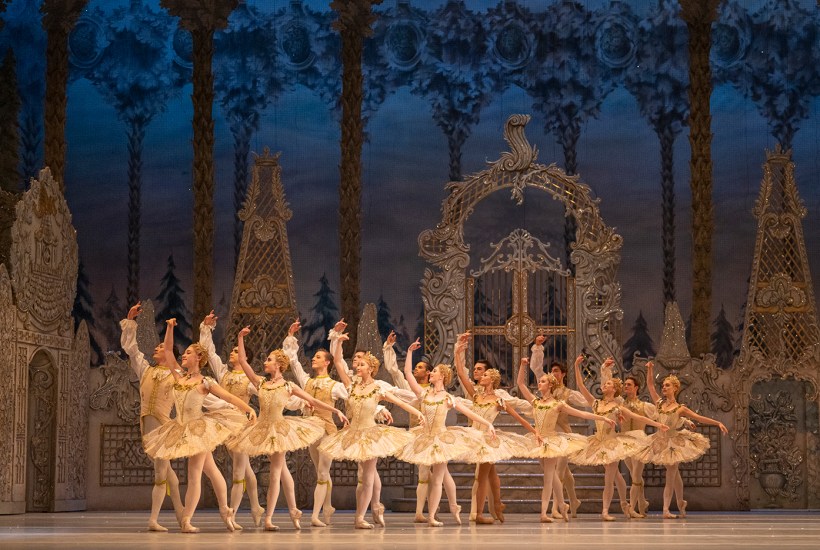The Nutcracker is one of those Christmas traditions that turns out to be not very traditional at all. First performed in St Petersburg in 1892, it didn’t catch on outside Russia until the late 1950s, when Balanchine’s version for New York City Ballet was repeatedly screened on network television in the USA and Festival Ballet’s production became a hardy perennial at the Royal Festival Hall. The Royal Ballet embraced it only in 1968; since then, it has become globally ubiquitous and an infallible money-spinner.
The enormous affection that The Nutcracker inspires is underpinned by a magnificent score that shows Tchaikovsky at his most freshly inventive (it’s bizarre that he composed it joylessly, under duress). Yet the dramatic scenario it illustrates is insolubly problematic. In the latter half of the first act lies a mysteriously powerful episode in which the cosy, domestic world of the opening scene becomes a sinister wonderland where Clara turns into an Alice figure, battling hostile forces as well as the confusing expansions of adolescence. Yet nothing in the second act develops this at all, leaving Clara as the spectator at a meaningless entertainment. It’s never clear whether the toymaker Drosselmeyer is controlling the magic, or is only an accessory to it.
And should a child be cast as Clara – thereby limiting the choreographic possibilities – or a diminutive adult ballerina required to act cute?
Nobody has addressed these conundrums more cogently than Peter Wright, who celebrated his 97th birthday by appearing at a matinée of his Birmingham Royal Ballet production. Although more than 30 years old, it remains a wonderful spectacle, brilliantly designed by John Macfarlane and offering awesome stagecraft in the way it transforms a damask-walled John Singer Sargent salon into a fantasy playground where giant rats slug it out with Napoleonic soldiers. Wright simplifies the plot by making Clara its sole focus, sacrificing some resonances by sidelining Drosselmeyer, but gaining in narrative coherence. His choreography is serviceable rather than inspired; BRB executes it with panache. But alterations to the score for the second act are clumsy and unmusical.
For his earlier production for the Royal Ballet, Wright returned to what little is known about the 1892 original and the story by E.T.A. Hoffmann that was its ultimate source. Drosselmeyer gets a nephew here, who turns out to be the nutcracker prince, trapped by a spell. I don’t feel this readily comes across in performance, but the staging has a richness of texture, compounded by the greens, golds and browns of Julia Trevelyan Oman’s Biedermeier designs, that makes it more emotionally involving than BRB’s. It is superlatively danced too, with Sae Maeda an engagingly winsome Clara and Gary Avis a flamboyant Drosselmeyer. (Casts vary throughout the run.)
English National Ballet’s version, the work of Toer van Schayk and Wayne Eagling, seems two-dimensional in comparison – a blandly Disneyish take on the story, with rather tacky and flimsy designs by Peter Farmer, that urgently need replacing. Clara is played by a child until she runs off stage halfway through the first act to be replaced by an adult, who later lands the Sugar Plum Fairy pas de deux before turning back into a child for an epilogue in which she wakes to the cliché of ‘was it all a dream?’ The performance as a whole felt lacklustre, though a full house in Southampton’s cavernous Mayflower Theatre lapped it up happily enough.
All of these productions qualify as trad, as do similar efforts by Scottish and Northern Ballet. Mark Morris and Matthew Bourne are only two of many choreographers who have reinterpreted the story more radically – Morris’s deliciously witty The Hard Nut ranking as an egregious success. This Christmas Drew McOnie joins their number with a small-scale essay for which Cassie Kinoshi has zippily reimagined the music for a jazz combo. McOnie has fashionably queered things so that Clara becomes Clive, suffering from a dad who wants his son playing with an Action Man rather than a Sugar Plum Fairy doll. This diverse and inclusive message is trumpeted so bluntly that I was left merely irritated.
Got something to add? Join the discussion and comment below.
Get 10 issues for just $10
Subscribe to The Spectator Australia today for the next 10 magazine issues, plus full online access, for just $10.
You might disagree with half of it, but you’ll enjoy reading all of it. Try your first month for free, then just $2 a week for the remainder of your first year.








Comments
Don't miss out
Join the conversation with other Spectator Australia readers. Subscribe to leave a comment.
SUBSCRIBEAlready a subscriber? Log in